The “Easy Easy Bebop” Method of Learning Jazz as a Language

lan·guage – the method of human communication.
Let me start by saying music is a universal language, and within jazz, there are various “accents”, if you will, such as blues, bebop, cool, swing, and the list goes on. Learning the bebop jazz language in a fun and easy way is the purpose of this concept I call, Easy Easy Bebop.
In many cases it can take months and even years to play bebop in a personal and expressive way. Most of the time, beginners are copying other musicians to get their sound. The Easy Easy Bebop concept is designed to help you hear your own musical voice in jazz “language”.
The Jazz “Conversation”
We usually start out copying other musicians to make sense of what we’re reading in jazz method books. We can get caught up in how to articulate the material when we first start learning jazz. Now that just about everything is written out with attempts to pen the intricate details of playing jazz, it can become a very intellectual study to play jazz. Many of us “musical bookworms” love this intellectual approach, but others get frustrated.
Some musicians are drawn to the spontaneous freedom of expression that jazz music allows – especially horn players because this music allows us to be featured out front. Playing jazz in a group is very conversational and “trading fours” is a great example of that.
Listening to what other players in the band have to say/play usually inspires an improvised response. Not only can we think in terms of theory, but we can think in terms of words to express the emotions of where we are as well as who’s listening, and from there, “sing” those feelings though our instrument.
The key being listening and then responding. Or, alternately, we might start the conversation and let others follow us. What are we thinking and what are we playing is what can reach the listener. We should be free enough to spontaneously grab things right out the atmosphere based on how we feel right at the moment.
Many of you have probably heard the story of Charlie Parker on the bandstand, mid-solo, playing the notes from another entirely different melody to compliment a lady who walked by as he was playing, and then switched right back into the original groove. He grabbed that sudden change in improvisational direction right out of the atmosphere, inspired by the woman’s beauty.
Freedom like that can come from expressing jazz as a language. Just as the “Cry Me a River” jazz lick is used to teach a specific bebop lick, over the years, I have been able to come up with many useful phrases to learn and teach with.
This short example below helps even the beginning jazz students start to play jazz as a language with expression. I use words which, as I like to think of it, linguistically, “Sing da Bebop“.
For example, if I play, the notes, C-D-E-G, sure, I can conceptualize those notes intellectually in terms of each note as a degree of a C major scale, like “1-2-3-5”.
However, it’s more meaningful if I think, “Play Some Be-bop”.
Bebop has always expressed different personalities by employing musical sounds that could be described as cool, bopping, swinging, bluesy, rhythmic, and romantic. We should continue that tradition, finding our own voice based on what we like about the music and its great players. We can appreciate other players, while having our own voice too. The reason why we say “find your own voice” is because bebop is a language.
Bebop didn’t come from books. It came from cool, slang-talking cats who could exchange musical ideas with words and notes. They would share licks and phrases by playing them and or singing them. Most of the books hadn’t been written yet. The sound and feel of the music was in the culture they were living and it came from within. That swing feel and bebop articulation was part of the conversation. It was a new and developing music.
In the past, they were dancing to it, partying to it and singing it. I still find that “Singing da Bebop” is a good way to learn bebop as a language. That’s my approach. Due to being around older players who schooled me when I was young, I’m now able to share that “say it, then play it” method of learning jazz.
Jazz articulation can be more than “Doo Dit Doo Dit“. Think of the old Sinatra song, “Strangers in the Night”, when he sang “Doo-Bee Doo-Bee Doo“. That’s nothing more than one of the ways jazz was communicated to him.
Try this one – “Doo-bee Doo-bee Doo-dit, Da Be-bop“.
That’s how cats would teach me a lick that never needed to be written down. Although they knew I could read it and some of them could write it out for me, they first got it in my ear. That way I could find it in other keys while I was soloing.
So once again, remember, bebop is a language. Play it as such is my suggestion. Still use the method books and learning devices of today, but also use your voice to sing or scat some of the notes you’re learning and wanting to remember. You’ll then begin to learn bebop as a language.
Simplifying the Not-So-Simple
Bebop uses accidental passing tones, enclosures and chromatic ideas that help extend lines longer and allow chord tones to fall on certain beats as part of the vocabulary. After getting into the approach I teach, most students begin to take on a different way of hearing and playing the music. You should start hearing, remembering and playing jazz with a more comprehensive language-based approach.
I have written down and shared many words and phrases that can be used to hear and remember specific jazz vocabulary with memorable expression.
In examples 1, 2, and 4 below, you will see the notation, words and scale numbers to include all three options for musicians. In the book I wrote around the concept of Easy Easy Bebop, although most of the licks and phrases are shown in twelve keys, after hearing them “sing” through your instrument, they are much more easily found in other keys. You’ll be finding the words, and not so worried about the notes. Your ear will guide you.
NOTE: In an effort to simplify things, the number 1 is used for the root, regardless of octave.
CLICK HERE FOR A MORE READABLE AND USER-FRIENDLY PDF OF THE EXERCISES BELOW.
Example 1. Easy Easy Bebop
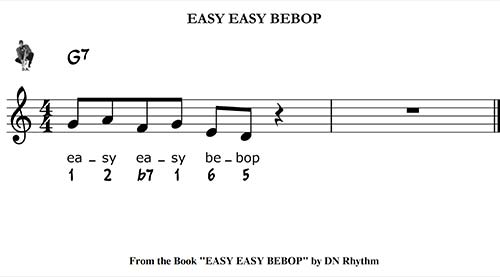
Example 2. Ev-ry Day I Bebop
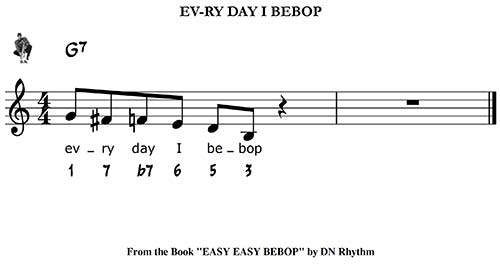
Example 3. Easy Easy Bebop Warmup (don’t just play, but sing these notes through your instrument)
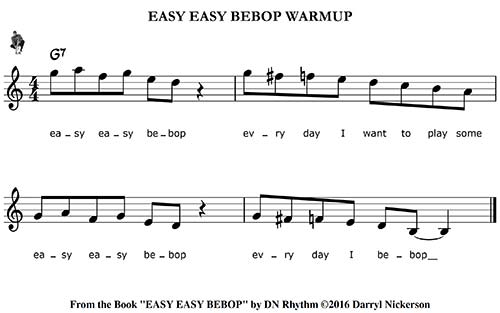
Example 4. Mellow Is The Bebop
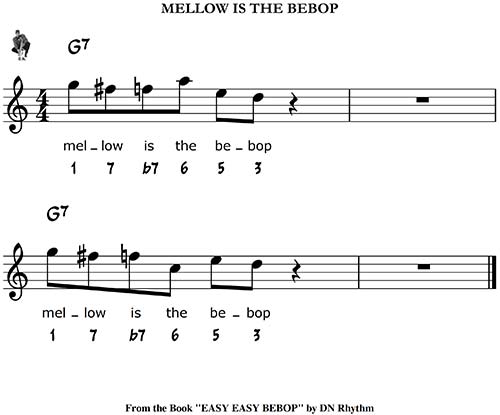
These are just a few examples that I have created based on “sayable and playable” words to get beginners started using this approach. The aim is to eventually hear the music in your own words, your own voice, while also hearing and writing jazz music as a musical language.




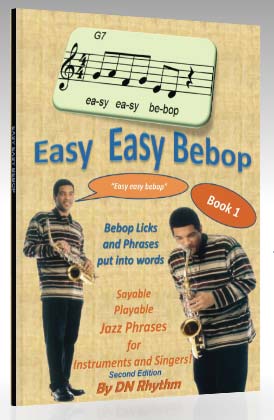


June 8, 2018 @ 5:19 pm
Incredible in its simplicity, sitting on my porch just singing through the rhythms, just bought the book.
THANK YOU#
June 8, 2018 @ 9:26 pm
I’m always glad to share with the music community. I always suggest using the Bebopish words, licks and phrases in the book before, in the middle and at the end of other things you like to play, adding to your vocabulary. The book helps to “Sing Da Bebop” in a fun and easy way. Have fun!
“Easy Easy Bebop”